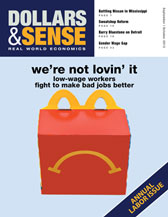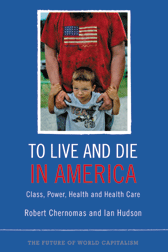This article is from Dollars & Sense: Real World Economics, available at http://www.dollarsandsense.org

This article is from the September/October 2013 issue of Dollars & Sense magazine.
Subscribe Now
at a 30% discount.

The Health of Nations
A review of To Live and Die in America: Class, Power, Health and Healthcare by Robert Chernomas and Ian Hudson (London: Pluto Press, 2013).
As is well known, the United States spends substantially more of its GDP on healthcare than other developed nations, yet gets back little for its money. Infant mortality in the United States is high, life expectancy is low, and many citizens lack decent care.
Standard economics offers two explanations for poor health outcomes in the United States. The biomedical approach blames our inadequate knowledge, and seeks to make us smarter when it comes to our health. The behavioral approach blames human inertia regarding eating well and exercising; it proposes free health club memberships that nudge us to exercise more, just as making participation in 401(k) plans the default option can increase savings.
In a readable, well-researched, and thoughtful contribution to this debate, Robert Chernomas and Ian Hudson criticize these two approaches. Then they offer their own explanation—poor health outcomes stem from power relationships that have an impact on our healthcare system and also on how people live and work. For example, lack of affordable childcare makes exercising difficult for young parents—even when they know that exercise is important and they get appropriate nudges.
Chernomas and Hudson make a case for a political-economy approach by examining living and working conditions as a cause of disease and poor health. They point out that health and politics cannot be separated, and they emphasize the positive correlation between working-class power and health outcomes across nations.
To Live and Die in America takes a broad historical perspective. Toward the end of the 19th century, British workers became more militant, successfully increasing wages and improving working conditions. Higher wages then improved nutrition and living conditions. In addition, unions gave workers more control over their lives.
As The Spirit Level (see my review in the May/June 2010 issue of Dollars & Sense) documents, many health benefits follow from greater income equality and from having greater control over one’s life. Some benefits come directly from reduced stress; others from the impact of reduced stress on individual behavior (such as eating “comfort foods” high in fat and sugar). Greater equality and control, Chernomas and Hudson argue, were responsible for the large improvements in health in the UK during the late 19th and early 20th century.
The United States started down a similar path early in the 20th century. Unions gained power, wages increased, and the workplace became safer. Political pressure for greater public health (financed by progressive taxation) and improved sanitation led to better health outcomes.
However, U.S. businesses began to seize the upper hand during the last quarter of the 20th century. Union membership declined, budget cutting reduced existing regulation, and firms used every legal means possible to challenge government regulations. All this put the health of average Americans at greater risk. Other nations, with stronger unions, maintained commitments to their citizens’ health.
Political-economy factors also impact access to healthcare. Some European countries provided universal health care to their citizens in the early 20th century because of labor support; in contrast, Teddy Roosevelt’s attempt to get national health insurance in 1912 met with strong opposition from the American Medical Association and inadequate support from a relatively weak labor movement.
In addition, business interests gained an upper hand in the U.S. healthcare system, so it now operates to enrich insurance and pharmaceutical firms while impoverishing those who get sick. U.S. government involvement in health care (Medicaid and Medicare, and now the Affordable Care Act, aka “Obamacare”), the authors argue, has enhanced profits for the powerful insurance and medical industries as much it has led to greater health care for the elderly and those without health insurance. The predictable result has been Kafkaesque bureaucracies (some public, but mostly private), high costs, mediocre care, and high profits.
Perhaps the best test of any thesis is how it deals with new data. Chernomas and Hudson pass this test with flying colors. The superb Lead Wars by Gerald Markowitz and David Rosner describes the battle to get the lead out of paint and gasoline. It documents how the U.S. government, unlike governments in Europe, provided succor to the lead industry, and how this led to numerous health problems in the United States. Their book documents how poor health results from corporate power rather than from people behaving irresponsibly by breathing bad air.
While Chernomas and Hudson are a bit too quick to dismiss nudges and the behavioral approach (they have increased savings rates a bit), To Live and Die in America is a well-researched and well-written introduction to health-care problems in the United States and some possible solutions. Its key contribution, bringing political-economy considerations into an analysis of health outcomes, deserves a wide hearing.
Did you find this article useful? Please consider supporting our work by donating or subscribing.
